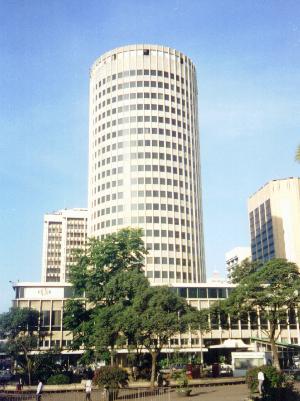|
Tourism:
|
Diani Beach on the south coast of Mombassa is a typical "tropical paradise" beach. Mombassa is the largest port on the
East coast of Africa; its docks serve Kenya, Uganda, Rwanda and Burundi. Mt Kilimanjaro or Kibo, in Amboseli National
Park, Africa’s highest peak and the highest mountain in the world, is the background of grassy plains with huge herds
of elephants and black rhinos. It is located in northern Tanzania, near the border with Kenya. The two peaks of
Kilamanjaro stand over 10 kilometers (6 miles) apart. Both are volcanic. The crater of Kibo is covered with ice that
reflects a very beautiful blue hue. 1200 Different species of birds can be found in Lake Baringo National park. The
spectacular annual wildebeest migration can be seen at Masai Mara National Reserve in the widely beautiful Serengeti
Plains.
|
|

Kilimanjaro/Ambuseli
©2001: Kenyalogy
Javier Gómez-García
|

Mombasa Serena Beach
©2001: Kenyalogy
Javier Gómez-García
|
|
SOME SWAHILI
- Hello — Jambo!
- How are you? — Habari?
- Where is the bathroom? — Iko wapi choo? (where = wapi)
- OK/fine — Sawa sawa
- Yes — Ndiyo (skip the 'N')
- No — Hapana
- Good — Mzuri (very good add 'sana' - 'mzuri sana')
- Bad — Mbaya - (very bad - 'mbaya sana')
- Please — Tafadali
- Thank you (very much) — Asante (very much — 'asante sana' the 'e' is the stressed and sounds like 'eh?' )
- Not Yet — Bado
- Big / Small — Kubwa / Kidogo
- Water — Maji
- Ice — Barafu
- Hot — Moto (physical heat 'Kali' is for hot food)
- Cold — Baridi ('Nataka beera baridi sana' — ' I want a cold beer')
- Tea — Chai (served at 4pm. 'Chai' also means a bribe)
- Coffee — Kahawa
- Milk — Maziwa
- Meat — Nyama ('Nyama choma' is cooked meat)
- Beer — Bia (beera, Tusker is the local beer)
- Lion — Simba
- Buffalo — Nyati
- Elephant — Tembo
- Rhino — Kifaro (or just 'faro')
- Leopard — Chui (pronounced 'chew-ee')
- Giraffe — Twiga
- Hippo — Kiboko
- Antelope — Swala
- Bird — Ndegi — Bird (also airplane)
- Cheetah — Ndoa Ndoa, Duma
- Bug — Dudu ("dudu kufa" for dead bug)
Nairobi:

Nairobi Hilton
|

Gedi Ruins
©2001: Kenyalogy
Javier Gómez-García
|
|
|
Nairobi is located at an altitude of 1,680m (5,500ft) above sea level. It has been Kenya's capital ever since the
country gained independence in 1963, and started as a British colonial railway settlement in the 1890's. Nairobi
became the British colonial capital of Ukamba province in 1899 and achieved it's city status in 1954. Today, Nairobi
is the leading industrial and commercial center of the country. Major industries include railways, tourism, and
light-manufacturing industries like beverages, cigarettes and processed food. It is well connected by roads, railways
and air with the rest of the country and to its neighboring countries. Nairobi is a gateway for trips to most of
Kenya's National Parks. The Jomo Kenyatta International Airport, named after Jomo Kenyatta - one of the principal
freedom fighting figures in Kenya, is a major international airport in Africa. Prominent buildings in the city
include the Kenyatta Conference Centre, the Parliament building and city hall, courts, Roman Catholic Cathedral,
University of Nairobi and its constituent institutions. Also, present in the city are the Central Government Archives,
National Museum of Kenya, McMillan Memorial Library, Kenyan National Theatre.
|
The Carnivore:

|
The only restaurant many foreigners seem to recall in Nairobi is the Carnivore. If you partake to a Kenyan safari, a stop at Carnivore, the popular Nairobi restaurant,
is obligatory. A tourist trap for the voracious appetites of the carnivorous khaki donning, camera slinging folk. Did
you know that crocodile meat tastes like chicken? Bloody or well-done, your choice. Cheetah, gazelle, giraffe, frog,
snake, zebra, ostrich, the meat you want is at Carnivore. Right after dinner and until dawn, Carnivore transforms into
a meet-and-dance place, the hottest in the Kenyan capital. It is the rendezvous of the moneyed tourist (no back packer!),
the businessman in recess, and, of course, the sophisticated pick-up girl.
|
The alternative to Carnivore is Pavement, in the Westlands neighbourhood. Seven days a week, both places offer live
entertainment, often starring an international artist. Klubhouse (there are two of them) cater to the local youth.
Half an hour drive from the centre is Bomas of Nairobi. It is a collection of villages of twelve Kenyan tribes,
showcasing differences in architecture, in functional and traditional design. Every day from 2:00 pm to 4:00 pm,
is held a folkloric show in the auditorium of the facility, featuring dancers, musicians, acrobats, and singers.
Mombasa:
Mombasa is the party capital of East Africa, the Cancun of sub-Sahara, a Caribbean island in the Indian Ocean. Night
spots are numerous and cater to different tastes. No need to recommend one over the next, having your spoonful of fun
is guaranteed anywhere you are in Mombasa. The nearby beaches of Kenya's dazzling Indian Ocean coast offer an irresistible
invitation. Behind the everyday bustle of modern Mombasa lies a long and eventful history. Kenya's second and oldest city,
it has had a rich and turbulent past, its deep natural harbour making it a key port on the classic trading routes between
Africa, Arabia, India and the Orient. Bygone echoes live on amid its ornate Hindu temples and intricate mosques,
imposing Fort Jesus (built by the Portuguese in 1593) - and the maze-like lanes of the old town, with their massive
studded wooden doors and tantalising glimpses of the old dhow harbour. Its history tells the story of the Kenyan people.
|

